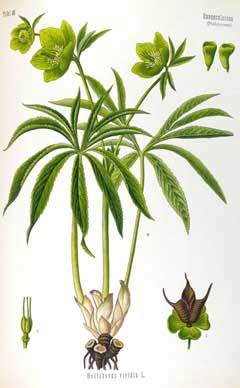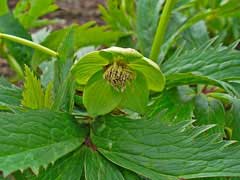 |
|
http://commons.wikimedia.org/wiki/File:Helleborus_viridis3.jpg |
 |
| http://commons.wikimedia.org/wiki/User:Llez |
Translate this page:
Summary
Physical Characteristics

 Helleborus viridis is a PERENNIAL growing to 0.3 m (1ft) by 0.3 m (1ft in).
Helleborus viridis is a PERENNIAL growing to 0.3 m (1ft) by 0.3 m (1ft in).
See above for USDA hardiness. It is hardy to UK zone 6 and is not frost tender. It is in flower from February to April, and the seeds ripen from May to June. The species is hermaphrodite (has both male and female organs) and is pollinated by Bees, flies.
Suitable for: light (sandy), medium (loamy) and heavy (clay) soils, prefers well-drained soil and can grow in heavy clay soil. Suitable pH: mildly acid, neutral and basic (mildly alkaline) soils and can grow in very alkaline soils.
It can grow in semi-shade (light woodland). It prefers moist soil.
UK Hardiness Map
US Hardiness Map
Synonyms
Plant Habitats
Woodland Garden Dappled Shade; Shady Edge; Ground Cover;
Edible Uses
References More on Edible Uses
Medicinal Uses
Plants For A Future can not take any responsibility for any adverse effects from the use of plants. Always seek advice from a professional before using a plant medicinally.
Anthelmintic Antiemetic Cardiac Cathartic Diuretic Emetic Emmenagogue Hypotensive
Irritant Narcotic Parasiticide Purgative
The root is anthelmintic, cardiac, cathartic, diuretic, emetic, emmenagogue, irritant, violently narcotic and a drastic purgative[4, 9, 21, 46]. The dried root is used, it contains the alkaloids nervine, pseudo-nervine and veratridine[213]. It is best to harvest the root in the autumn[213]. The plant is useful for reducing blood pressure in various conditions of hypertension[213].
References More on Medicinal Uses
The Bookshop: Edible Plant Books
Our Latest books on Perennial Plants For Food Forests and Permaculture Gardens in paperback or digital formats.

Edible Tropical Plants
Food Forest Plants for Hotter Conditions: 250+ Plants For Tropical Food Forests & Permaculture Gardens.
More

Edible Temperate Plants
Plants for Your Food Forest: 500 Plants for Temperate Food Forests & Permaculture Gardens.
More

More Books
PFAF have eight books available in paperback and digital formats. Browse the shop for more information.
Shop Now
Other Uses
Parasiticide
A decoction of the roots is used as a parasiticide against body lice, fleas etc[76, 213]. This use is somewhat dangerous, see the notes above on toxicity. Plants are suitable for ground cover when spaced about 45cm apart each way[208].
Special Uses
Ground cover
References More on Other Uses
Cultivation details
Cultivation of this plant is not always easy, it prefers a rich limy soil in partial shade[187]. One report says that the plant requires an alkaline soil[17]. Succeeds in any good garden soil[1], preferring a moist well-drained rich loam in a sheltered position in partial shade[1, 4, 31, 111]. Succeeds when grown in the shade of a north-facing wall[233]. Does not object to lime[1]. Grows well in heavy clay soils[200]. Dislikes drought. Slugs are very fond of this plant and it will probably require some protection from them[187]. The various species in this genus hybridize freely[95]. Plants resent root disturbance and should be placed in their permanent positions whilst still small[200]. A greedy plant, inhibiting the growth of nearby plants, especially legumes[54].
References Carbon Farming Information and Carbon Sequestration Information
Temperature Converter
Type a value in the Celsius field to convert the value to Fahrenheit:
Fahrenheit:
The PFAF Bookshop
Plants For A Future have a number of books available in paperback and digital form. Book titles include Edible Plants, Edible Perennials, Edible Trees,Edible Shrubs, Woodland Gardening, and Temperate Food Forest Plants. Our new book is Food Forest Plants For Hotter Conditions (Tropical and Sub-Tropical).
Shop Now
Plant Propagation
Seed - best sown as soon as it is ripe in a cold frame[1, 134]. Sow stored seed as early in the year as possible[1], it usually germinates in the autumn to spring. Seed can take 18 months to germinate. When they are large enough to handle, prick the seedlings out into individual pots and grow them on in a lightly shaded position in the greenhouse for their first winter. Plant them out into their permanent positions in late spring or early summer, after the last expected frosts. This species produces flowering plants in 2 - 3 years from seed[200]. Division after flowering or in autumn. Take care since the plant resents disturbance[111, 200].
Other Names
If available other names are mentioned here
Native Range
EUROPE: United Kingdom, Austria, Belgium, Switzerland, Germany, Italy (north), Spain (north), France
Weed Potential
Right plant wrong place. We are currently updating this section.
Please note that a plant may be invasive in one area but may not in your area so it's worth checking.
Conservation Status
IUCN Red List of Threatened Plants Status :

Growth: S = slow M = medium F = fast. Soil: L = light (sandy) M = medium H = heavy (clay). pH: A = acid N = neutral B = basic (alkaline). Shade: F = full shade S = semi-shade N = no shade. Moisture: D = dry M = Moist We = wet Wa = water.
Now available:
Food Forest Plants for Mediterranean Conditions
350+ Perennial Plants For Mediterranean and Drier Food Forests and Permaculture Gardens.
[Paperback and eBook]
This is the third in Plants For A Future's series of plant guides for food forests tailored to
specific climate zones. Following volumes on temperate and tropical ecosystems, this book focuses
on species suited to Mediterranean conditions—regions with hot, dry summers and cool, wet winters,
often facing the added challenge of climate change.
Read More
Expert comment
Author
L.
Botanical References
17200
Links / References
For a list of references used on this page please go here
Readers comment
© 2010, Plants For A Future. Plants For A Future is a charitable company limited by guarantee, registered in England and Wales. Charity No. 1057719, Company No. 3204567.